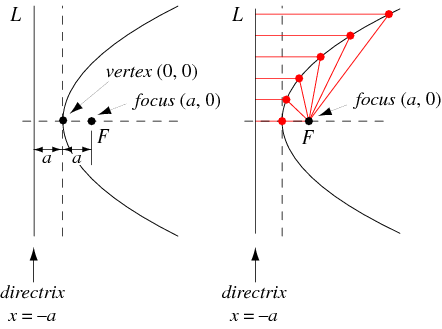1. 30* Triangle - This is the smallest angle that is opposite to the smallest side. The 30* angle can be rewritten as radians and is π/6. To convert the * to radians, you use a conversion shown as 30 x π/18. The coordinates for this on a plane are (√3/2,1/2) in quadrant I when plotting the Unit Circle. The unit circle is essentially a circle with the radius of 1. The reference angle is how far an angle is from the x intercept. For 30* angles and its coterminals(angles with the same reference angle), the reference angle is 30*.
2. 45* Triangle - This is one of the special right triangles (isosceles) that has two sides that are the same angle (45*) and a 90* angle. For converting to radians, 45* x π/180 that results with π/4 in quadrant 1. The sides are in a ratio of 1:1: √2 In a unit circle, the coordinates would be ( √2/2, √2/2) in quadrant I. As for the reference angle, it would be 45* Angles with the same reference angle are 135*, 225*, & 345* that are within 1 revolution.
3. 60* Triangle - The 60* triangle is part of the 30* triangle to make up the special 30/60/90 right triangle. The 60* angle is the largest angle between the 30/45/60*. In radians, 60* x π/180 = π/3 in quadrant 1. The ordered pair for a 60* angle is (1/2,√3/2) which is the inverse of the 30 ordered pair in quadrant I. The reference angle for a 60* triangle is 60*. For angles that have a reference degree of 60*, the angles are: 60*, 120*, 240*, 300* These angles are within the 1 revolution of a unit circle.
4. This activity helps me derive the Unit Circle because the first quadrant is comprised of these angles and knowing these angles helps me figure out the rest of the quadrants in the unit circle. There are certain patterns like how much π increases each time or how the reference angles work in a way to make sense and the (+-) for coordinates are supposed to look like. By knowing the special properties of the 3 degrees and its radians, I am able to completely fill out the rest of the unit circle in under 5 minutes without any problems except for the occasional (+-) for the coordinates.



\
5. All of the angles mentioned above lie in the first quadrant of the unit circle. These values change by degrees, radians, and ordered pairs when drawn in different quadrants because of the special properties of the circles. Notice the 150* in quadrant 2, even though the reference angle may be the same as the 30* in the first quadrant, the new angle and its radians are completely different from the original 30*. Its ordered pairs may look the same but the x value has become a negative because the angle is in the left side (negative side) of the graph but the y value stays the same because it is still in the positive side of the graph. In the third quadrant, there is a 225* with the reference angle of 45* that is similar to the 45* in the first quadrant. However, like the 30*, even though the reference is the same, the angle, radians, and ordered pairs are completely different from the 45* in the first quadrant. As for the 300* in the fourth quadrant, the reference angle is 60* like the first quadrant but the 300*, the radian, and the ordered pair specified in the fourth quadrant are completely different from the 60* in the first quadrant. This is also seen when the angles with the same reference angle are drawn in all the quadrants and connecting them would make a quadrilateral in the unit circle. The values for each point on the unit circle are identical except for the (+-) which is determined by where the point is on the graph. With this, it helps determine the rest of the unit circle and its values just by using the first quadrant and the 3 special right triangles.
Inquiry Activity Reflection
The coolest thing I learned from this activity was a single angle can have an infinite possibility of coterminal angles.
This activity will help me in this unit because all the concepts revolve around knowing the unit circle and the special properties of the angles in the unit circle. The concepts that are most important in relation to the unit circle are 7,8,9.
Something I never realized about special right triangles and the unit circle is how the special right triangle shows up in the unit circle and plays a significant role in filling out the rest of the unit circle and how the unit circle actually has a method for completing it when I all did last year was try to memorize everything.

